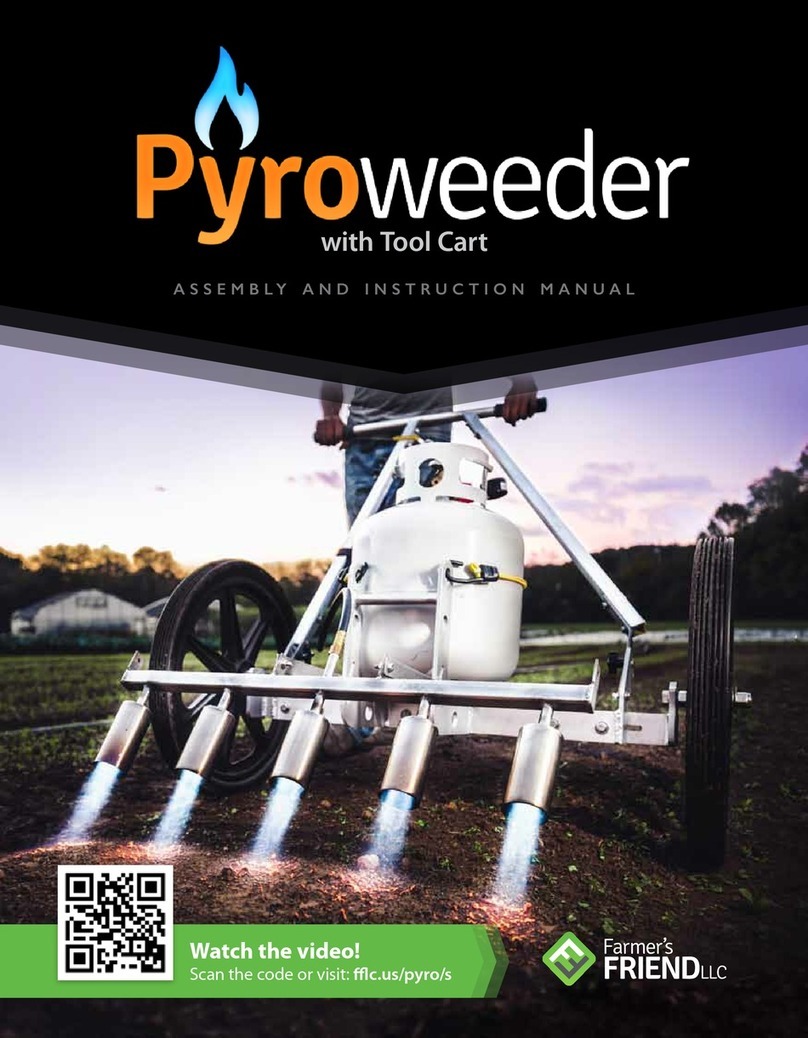
Pyroweeder 30
Tank-mounted Valve
Pyroweeder 30
Handle-mounted Valve
Pyroweeder 48
Tank-mounted Valve
Pyroweeder 48
Handle-mounted Valve
(931) 583-0397 | support@farmersfriendllc.com
FOR YOUR SAFETY
1. Protect your feet—always wear shoes when
operating the Pyroweeder.
2. Take safety precautions around children, pets,
and small animals.
3. Keep hands and feet away from burners while
the machine is operating. Flame may not be
visible in bright sunlight. The burner flames are
most visible when the Pyroweeder is operated
during lower light conditions, such as at dawn or
dusk.
4. Close the propane-tank valve when not in use.
5. Be prepared to promptly ignite the propane
upon opening the control valve for use. Do not
allow prolonged propane flow to un-ignited
burners. If excessive unburned propane flow
occurs, close the control valve and wait for
the propane to dissipate before attempting to
ignite the burners.
6. Keep the propane tank upright while operating
the Pyroweeder. It is recommended that you
use at least two bungee cords to secure the
tank against the tank brace.
Safety
IMPORTANT WARNINGS
1. Read all safety instructions before first use.
2. The Pyroweeder is intended for agricultural
weed management only.
3. Propane is extremely flammable. Before each
use, inspect hoses, valves, and connections for
damage or leaks.
4. Carbon monoxide gas is a poison—it can kill.
Since it is colorless and odorless, it is especially
dangerous. Incomplete propane combustion will
produce carbon monoxide; you can recognize
incomplete combustion by a yellow flame. On
the other hand, complete combustion produces
a blue flame. To operate the Pyroweeder safely,
adjust the pressure and control valve to avoid
a yellow flame—make it blue. Symptoms of
carbon monoxide poisoning include headache,
weakness, dizziness, nausea, vomiting,
confusion, and fatigue. If you have reason to
believe that you or anyone else has carbon
monoxide poisoning, move to fresh air and seek
immediate emergency medical care.
5. Prevent wildfires by complying with local
burn bans.
6. Practice fire safety—do not use on dry
grass, leaves, or brush, or during high fire-risk
conditions.
7. Do not operate in high-wind conditions.
8. Do not operate indoors or in an enclosed space.
9. Do not allow a child to operate the Pyroweeder.
10. Do not operate the Pyroweeder if your
coordination, balance, or judgment are impaired
by any medication, alcohol, or drug.
11. Do not store propane tanks indoors. Store
propane in a cool, well-ventilated outdoor
location.
12. Do not allow the Pyroweeder to tilt back onto
its handle while it is operating.
Rev. 20191205
The Flame Weeder, Refined






























